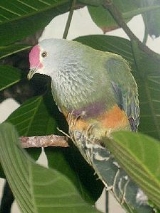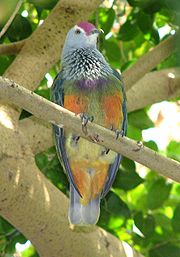
Mariana Fruit Dove
Encyclopedia
The Mariana Fruit Dove, Ptilinopus roseicapilla, also known locally as Mwee’mwe in the Carolinian
language, Totot on Guam or Paluman Totut in Northern Mariana Islands, is a small, up to 24 cm long, green fruit dove native and endemic
to Guam
and the Northern Marianas Islands in the Pacific. It has a red forehead, greyish head, back and breast, and yellow belly patch and undertail coverts.
The female lays a single white egg. The chick and egg are tended to by both parents. Its diet consists mainly of fruits.
Culturally, the Mariana Fruit Dove is a very important symbol of the region. This species is the official bird of the Northern Marianas Islands.http://www.pacificislands.cc/pina/pinadefault2.php?urlpinaid=18620. In 2005, the Mariana Fruit Dove was originally chosen as the official mascot of the 2006 Micronesian Games
in Saipan
.http://www.pacificislands.cc/pina/pinadefault2.php?urlpinaid=18620 However, the official website for the games shows a tropicbird
as the official symbol instead of the Mariana Fruit Dove.http://cnmi.net/microgames/
 The species faces extinction due to habitat loss throughout its range. A larger threat to the Mariana Fruit Dove has been the accidental introduction of the Brown tree snake
The species faces extinction due to habitat loss throughout its range. A larger threat to the Mariana Fruit Dove has been the accidental introduction of the Brown tree snake
to Guam during World War II
. The snakes decimated the native bird populations of the island, which were unaccustomed to predators. They are extinct on Guam and the Mariana Fruit Dove is highly endangered on other islands in its range. The spread of the snakes to other Northern Marianas Islands could be devastating. Several zoos have started captive breeding programs. The St. Louis Zoo, in St. Louis, Missouri
, has one of the most successful captive breeding programs. The program began in 1993.http://www.stlzoo.org/animals/abouttheanimals/birds/pigeonsdoves/marianasfruitdo01.htm
Due to ongoing habitat loss, limited range, small population size and invasive alien species, the Mariana Fruit Dove is evaluated as Endangered on the IUCN Red List
of Threatened Species.
Carolinian language
Carolinian is an Austronesian language spoken in the Northern Mariana Islands, where it is an official language along with English and Chamorro. Spoken mostly by the Carolinian people, Carolinian is most closely related to Satawalese, Woleaian, and Puluwatese...
language, Totot on Guam or Paluman Totut in Northern Mariana Islands, is a small, up to 24 cm long, green fruit dove native and endemic
Endemism in birds
An endemic bird area is a region of the world that contains two or more restricted-range species, while a "secondary area" contains one or more restricted-range species. Both terms were devised by Birdlife International....
to Guam
Guam
Guam is an organized, unincorporated territory of the United States located in the western Pacific Ocean. It is one of five U.S. territories with an established civilian government. Guam is listed as one of 16 Non-Self-Governing Territories by the Special Committee on Decolonization of the United...
and the Northern Marianas Islands in the Pacific. It has a red forehead, greyish head, back and breast, and yellow belly patch and undertail coverts.
The female lays a single white egg. The chick and egg are tended to by both parents. Its diet consists mainly of fruits.
Culturally, the Mariana Fruit Dove is a very important symbol of the region. This species is the official bird of the Northern Marianas Islands.http://www.pacificislands.cc/pina/pinadefault2.php?urlpinaid=18620. In 2005, the Mariana Fruit Dove was originally chosen as the official mascot of the 2006 Micronesian Games
2006 Micronesian Games
The 6th Micronesian Games were held on Saipan, Northern Mariana Islands from June 23-July 7, 2006. The Games featured competition in 16 different sports/disciplines....
in Saipan
Saipan
Saipan is the largest island of the United States Commonwealth of the Northern Mariana Islands , a chain of 15 tropical islands belonging to the Marianas archipelago in the western Pacific Ocean with a total area of . The 2000 census population was 62,392...
.http://www.pacificislands.cc/pina/pinadefault2.php?urlpinaid=18620 However, the official website for the games shows a tropicbird
Tropicbird
Tropicbirds are a family, Phaethontidae, of tropical pelagic seabirds now classified in their own order Phaethontiformes. Their relationship to other living birds is unclear, and they appear to have no close relatives. There are three species in one genus, Phaethon...
as the official symbol instead of the Mariana Fruit Dove.http://cnmi.net/microgames/

Brown tree snake
The brown tree snake is an arboreal rear-fanged colubrid snake native to eastern and northern coastal Australia, Papua New Guinea, and a large number of islands in northwestern Melanesia....
to Guam during World War II
World War II
World War II, or the Second World War , was a global conflict lasting from 1939 to 1945, involving most of the world's nations—including all of the great powers—eventually forming two opposing military alliances: the Allies and the Axis...
. The snakes decimated the native bird populations of the island, which were unaccustomed to predators. They are extinct on Guam and the Mariana Fruit Dove is highly endangered on other islands in its range. The spread of the snakes to other Northern Marianas Islands could be devastating. Several zoos have started captive breeding programs. The St. Louis Zoo, in St. Louis, Missouri
St. Louis, Missouri
St. Louis is an independent city on the eastern border of Missouri, United States. With a population of 319,294, it was the 58th-largest U.S. city at the 2010 U.S. Census. The Greater St...
, has one of the most successful captive breeding programs. The program began in 1993.http://www.stlzoo.org/animals/abouttheanimals/birds/pigeonsdoves/marianasfruitdo01.htm
Due to ongoing habitat loss, limited range, small population size and invasive alien species, the Mariana Fruit Dove is evaluated as Endangered on the IUCN Red List
IUCN Red List
The IUCN Red List of Threatened Species , founded in 1963, is the world's most comprehensive inventory of the global conservation status of biological species. The International Union for Conservation of Nature is the world's main authority on the conservation status of species...
of Threatened Species.

